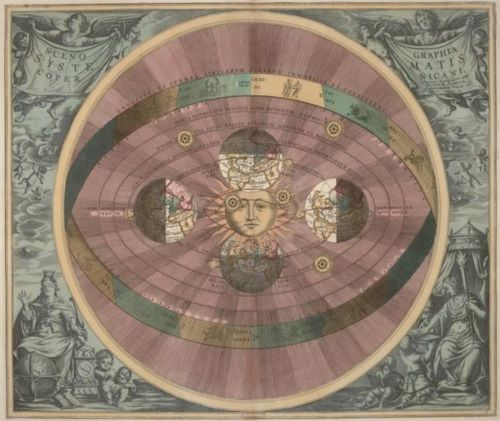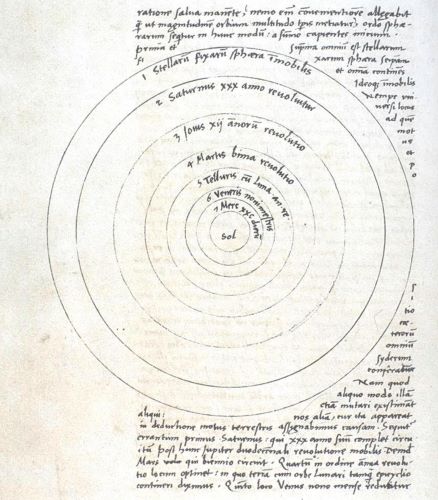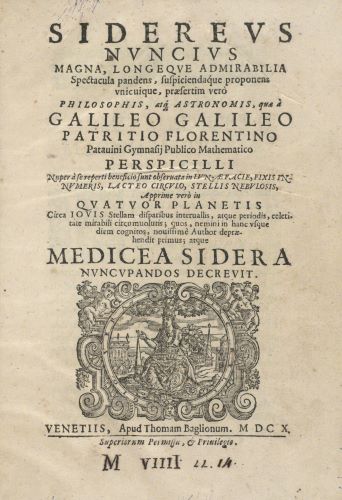

Heliocentrism’s triumph reshaped the epistemological foundations of knowledge itself.

By Matthew A. McIntosh
Public Historian
Brewminate
Introduction
The intellectual revolution that transformed humanity’s understanding of the cosmos during the Renaissance was neither instantaneous nor uncontested. For over a millennium, the geocentric model, most fully articulated by Ptolemy in the Almagest, dominated Western cosmology. Rooted in classical philosophy and bolstered by ecclesiastical authority, this Earth-centered vision seemed self-evident—both to the eye and to the theological mind. But with the rise of Renaissance humanism and the reawakening of scientific curiosity, new observations and theoretical frameworks began to challenge this orthodoxy. The heliocentric model, advanced by Nicolaus Copernicus and later refined by Kepler and Galileo, would ultimately overturn centuries of belief, reorienting not only astronomy but the very place of humanity in the universe.
The Authority of Geocentrism in the Pre-Renaissance World
The geocentric model found its most complete classical expression in the works of Claudius Ptolemy (c. 100–170 CE), whose Almagest synthesized earlier Greek astronomical thought, particularly that of Aristotle and Hipparchus. In this model, Earth occupied the immobile center of a nested series of concentric spheres. The planets, sun, and stars were embedded in these crystalline orbs, which rotated in perfect circles. While mathematically complex, the model effectively predicted celestial motions through mechanisms such as epicycles and deferents—mathematical constructs designed to preserve circular motion and explain irregular planetary paths.1
Philosophically, Ptolemaic geocentrism aligned closely with Aristotelian physics, which posited a qualitative difference between the sublunary (Earthly) and celestial realms. The Earth was composed of the four corruptible elements—earth, water, air, and fire—while the heavens were made of aether, a perfect and immutable substance. Celestial bodies were believed to move in eternal, unchanging circles, a concept which not only framed ancient science but reinforced a teleological worldview in which everything had a divinely ordained place.2
This geocentric cosmos was deeply theologized in the medieval Christian world. Drawing on Ptolemaic and Aristotelian models, medieval scholars like Thomas Aquinas incorporated geocentrism into scholastic theology, presenting the cosmos as a hierarchical creation with Earth—and by extension, humanity—at its apex. The stationary position of Earth was not merely a physical claim, but a spiritual one: mankind occupied the center of divine concern. Any challenge to that model thus risked not just scientific debate but theological heresy.3
Institutionally, geocentrism gained further longevity through its adoption by the Catholic Church, which came to regard Ptolemaic astronomy as compatible with scriptural teachings. Biblical passages—such as Psalm 104:5 (“The Lord set the earth on its foundations; it can never be moved”)—were interpreted literally, and Church doctrine emphasized the Earth’s fixity. This fusion of cosmology and theology created an intellectual environment resistant to empirical revision and suspicious of speculative alternatives.4
Copernicus and the Heliocentric Challenge

The seeds of cosmological revolution were sown in the early 16th century with the publication of Nicolaus Copernicus’ De revolutionibus orbium coelestium (1543). A Polish cleric and astronomer, Copernicus proposed a radically different model: that the sun, not the Earth, was at the center of the universe, and that the Earth both rotated on its axis and orbited the sun annually.5 Though Copernicus still adhered to circular orbits and retained epicycles in his calculations, his system simplified planetary motion and explained retrograde motion—the apparent backward movement of planets—as an optical illusion arising from Earth’s motion, rather than requiring epicyclic complexity.
Copernicus’ motivations were as mathematical and philosophical as they were observational. Frustrated by the inelegant and convoluted nature of Ptolemaic astronomy, he sought a more harmonious, geometrically consistent model of the heavens. Influenced by Neoplatonic ideals of symmetry and mathematical beauty, Copernicus believed the universe should conform to orderly principles. His heliocentrism was thus not an empirical revolution in the modern sense, but a cosmological hypothesis grounded in the quest for theoretical elegance.6
Despite the elegance of the heliocentric theory, Copernicus’ work had limited immediate impact. His ideas were met with cautious interest rather than outright acceptance. Many astronomers admired the mathematical innovation but remained unconvinced of its physical reality. Notably, Copernicus’ model still assumed celestial spheres and offered no compelling physical mechanism—such as inertia or gravity—to explain why the Earth could move without sensation.7 Without a viable physics to support the motion of Earth, his model remained philosophically controversial and physically suspect.
Moreover, Copernicus’ heliocentrism was theologically provocative. Although he dedicated his work to Pope Paul III and framed it as a mathematical hypothesis, some Church authorities perceived it as undermining scriptural literalism. The Protestant reformer Martin Luther reportedly mocked the theory as contradicting the Bible. Still, the Copernican model circulated quietly among scholars, awaiting stronger observational support and theoretical foundations that would come in the next century.8
Galileo, Kepler, and the Triumph of Observation

It was not until the 17th century that empirical observation began to decisively challenge geocentrism. The invention of the telescope, most famously utilized by Galileo Galilei, marked a turning point. Galileo’s observations of the moons of Jupiter, the phases of Venus, and the imperfections on the Moon’s surface dealt serious blows to the geocentric and Aristotelian models. The moons orbiting Jupiter proved that not all celestial bodies revolved around Earth, and the phases of Venus only made sense within a heliocentric framework.9
Galileo’s discoveries, published in Sidereus Nuncius (1610) and later works, provided visual evidence that undermined the Church-sanctioned cosmos. His use of empiricism and mathematical reasoning over purely philosophical speculation was emblematic of the emerging scientific method. Galileo also became an outspoken advocate of Copernican heliocentrism, insisting it reflected the true structure of the universe and not merely a convenient mathematical tool.10
However, Galileo’s advocacy brought him into conflict with the Catholic Church, particularly the Inquisition, which viewed heliocentrism as contradicting scriptural authority. In 1633, Galileo was tried and forced to recant, and his works were placed on the Index of Forbidden Books. The trial illustrated the deep entanglement of cosmology with religious and institutional power—and the high cost of challenging orthodoxy.11 Yet despite this repression, Galileo’s findings continued to influence a new generation of thinkers and laid the groundwork for broader acceptance of heliocentrism.
Alongside Galileo, Johannes Kepler advanced heliocentrism through mathematical precision. By analyzing Tycho Brahe’s astronomical data, Kepler formulated his three laws of planetary motion, replacing circular orbits with ellipses and demonstrating that planets move faster when closer to the sun. Published in Astronomia nova (1609) and Harmonices Mundi (1619), Kepler’s work offered a predictive, empirical, and geometrically consistent model of the solar system—resolving many of the problems Copernicus had left unanswered.12
Toward a New Cosmology: Scientific and Philosophical Implications
The shift from geocentrism to heliocentrism was not merely a change in astronomical models—it represented a philosophical revolution. The displacement of Earth from the center of the cosmos shattered long-standing assumptions about human centrality and cosmic purpose. As the universe expanded in both physical and conceptual terms, humanity’s perceived status in creation became profoundly destabilized. This cognitive displacement would echo in philosophical, theological, and existential reflections for centuries to follow.13
The heliocentric model also catalyzed the Scientific Revolution. By prioritizing empirical observation, mathematical reasoning, and mechanistic explanations, early modern astronomers and natural philosophers laid the foundations for modern science. Figures such as Isaac Newton would synthesize Kepler’s laws and Galileo’s mechanics into a universal framework of gravitation, providing the final confirmation that heliocentrism not only described the heavens but also explained them through natural law.14
The transformation was gradual. Even into the late 17th century, some scholars continued to cling to geocentric or hybrid models, such as Tycho Brahe’s geoheliocentric system. Yet the intellectual tide had turned. The accumulation of evidence, along with the explanatory power of the heliocentric system, slowly pushed geocentrism to the margins. By the time of Newton’s Principia Mathematica (1687), the Earth’s motion around the sun was no longer a daring hypothesis but a demonstrable truth.15
Ultimately, the triumph of heliocentrism reshaped not only the structure of the heavens but the epistemological foundations of knowledge itself. No longer could ancient authority or scriptural literalism alone dictate the shape of the cosmos. Observation, calculation, and falsifiability became the new pillars of truth. In this sense, the Copernican Revolution was not merely a scientific transformation—it was a cultural reorientation, one that continues to define the modern intellectual worldview.16
Appendix
Endnotes
- David C. Lindberg, The Beginnings of Western Science, 2nd ed. (Chicago: University of Chicago Press, 2007), 250.
- Thomas S. Kuhn, The Copernican Revolution: Planetary Astronomy in the Development of Western Thought (Cambridge: Harvard University Press, 1957), 69–72.
- Edward Rosen, Copernicus and the Scientific Revolution (New York: Harper & Row, 1984), 24.
- Robert S. Westman, The Copernican Question: Prognostication, Skepticism, and Celestial Order (Berkeley: University of California Press, 2011), 43.
- Rosen, Copernicus and the Scientific Revolution, 29.
- Kuhn, The Copernican Revolution, 133.
- Westman, The Copernican Question, 159.
- Lindberg, The Beginnings of Western Science, 314.
- Galileo Galilei, Sidereus Nuncius, trans. Albert Van Helden (Chicago: University of Chicago Press, 1989), 32–38.
- Ibid., 42.
- Kuhn, The Copernican Revolution, 218.
- Westman, The Copernican Question, 276.
- Lindberg, The Beginnings of Western Science, 330.
- Kuhn, The Copernican Revolution, 256.
- Rosen, Copernicus and the Scientific Revolution, 187.
- Westman, The Copernican Question, 339.
Bibliography
- Galilei, Galileo. Sidereus Nuncius. Translated by Albert Van Helden. Chicago: University of Chicago Press, 1989.
- Kuhn, Thomas S. The Copernican Revolution: Planetary Astronomy in the Development of Western Thought. Cambridge: Harvard University Press, 1957.
- Lindberg, David C. The Beginnings of Western Science. 2nd ed. Chicago: University of Chicago Press, 2007.
- Rosen, Edward. Copernicus and the Scientific Revolution. New York: Harper & Row, 1984.
- Westman, Robert S. The Copernican Question: Prognostication, Skepticism, and Celestial Order. Berkeley: University of California Press, 2011.
Originally published by Brewminate, 07.08.2025, under the terms of a Creative Commons Attribution-NonCommercial-NoDerivatives 4.0 International license.


